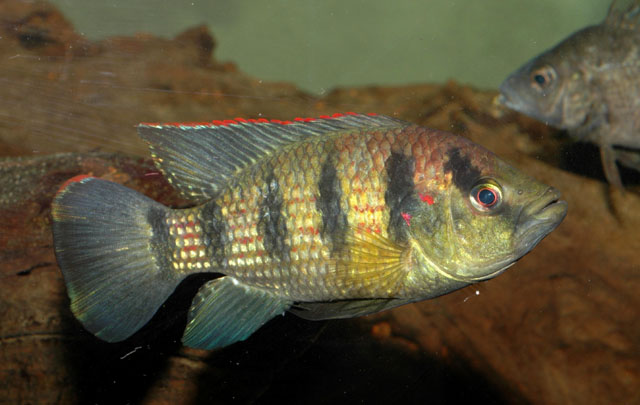| Cichlidae (Cichlids), subfamily: Pseudocrenilabrinae |
| 18.7 cm SL (male/unsexed) |
|
benthopelagic; pH range: 7; dH range: 15 |
| Africa: Cameroon to the Republic of Congo, the entire Congo River, Okavango and Zambesi system (Ref. 81260) and the Cuanza River (Ref. 11970). Also reported from west Africa (Guinea, Sierra Leone, Liberia, Togo, Benin, Nigeria) (Ref. 43352, 81260), but this needs confirmation (Ref. 53405). Upper Zambezi and (some) Congo populations may represent a different species (Ref. 81260). |
|
Dorsal spines (total): 13-15; Dorsal soft rays (total): 11-12; Anal spines: 3-3; Anal soft rays: 8-10. Diagnosis: 4-5 distinct blotches or ovoid bars along lateral mid-line (Ref. 44091, 81260), but bands not obvious in large males which assume a very dark to almost black coloration (Ref. 44091). Scales olive to yellow; series of thin red dots often forming horizontal lines along the mid-portion of flanks; normally 2 rows of teeth on upper jaw (Ref. 81260). Magenta spot on gill cover (Ref. 44091).
Description: relatively elongate, body depth 31.3-39.4% SL; head large (length 35.5-39.0% SL); snout acute; mouth prominent with highly protrusile upper jaw; lower jaw markedly prognathous; lower lip fold broad, completely covers upper lip at corner of mouth; normally 2 full rows of teeth in upper jaw: outer row with a few slightly enlarged canines near symphysis, inner row of tiny unicuspids separated from outer row by a wide gap; rakers near ceratobranchial-epibranchial angle often distally flattened and anvil-shaped; first pelvic ray longest in both sexes; some dorsal and anal fin rays elongated; caudal fin subtruncate in both sexes; chest scales smaller than body scales (Ref. 81260).
Coloration: base body colour olive to yellow, with dorsum slightly darker than chest and belly; opercular spot very well-developed and prominent; 4-5 prominent black blotches, or elongated ovoid bars along lateral mid-line to caudal peduncle base; throat and venter normally creamy or rosy; in breeding, coloration of most of the venter is dusky grey to black while flanks are often flushed deep red; a series of small red dots, often forming thin red lines, run along the flanks; these are mostly concentrated in the mid-lateral region, becoming less intense dorsally and ventrally; dorsal fin, and sometimes upper part of caudal fin, with thin red margin and often a thin white submargin; pectorals hyaline, other fins yellowish to dusky grey; a narrow dark lachrymal stripe usually present; juveniles (< 15 mm) yellow or pale brownish with a very strong and prominent mid-lateral black band (Ref. 81260). |
| Found in shallow lakes and streams (Ref. 58302). Highly predaceous and thus used in some areas for tilapia control; feeds on fish, shrimp and aquatic insects; very aggressive and territorial (Ref. 44091); the parents guard the nest and larvae (Ref. 7248). Pair-bonding, substrate brooder (Ref. 81260). Oviparous (Ref. 205). |
|
(Ref. 96402)
|
| harmless |
|
Source and more info: www.fishbase.org. For personal, classroom, and other internal use only. Not for publication.
Page created by Jen, 05.08.02,
php script by kbanasihan 06/09/2010 ,
last modified by
dsantos, 20/08/10

